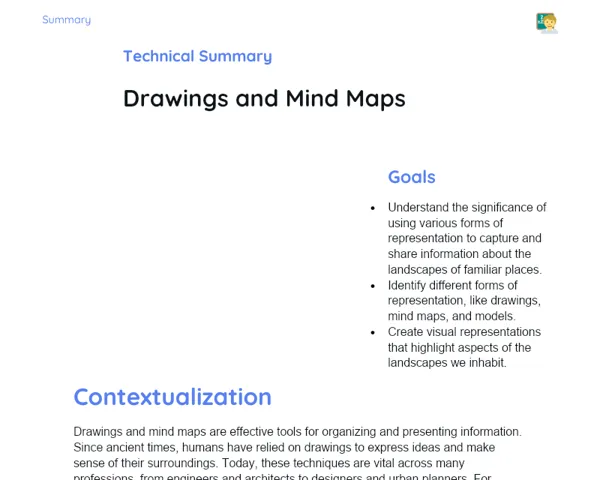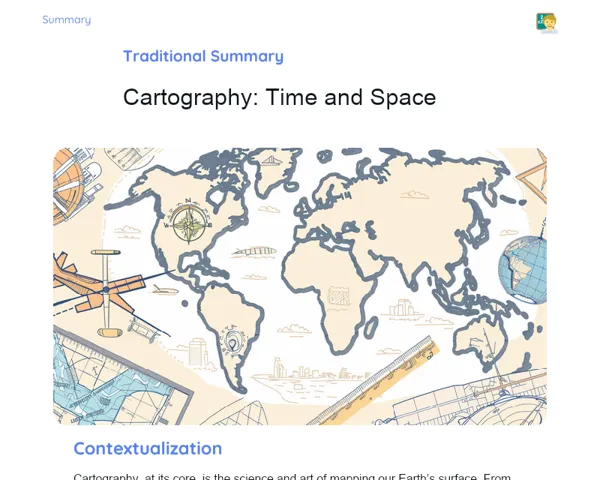Summary Tradisional | Amazon: Biomes, Economy and Environmental Impacts: Review
Contextualization
The Amazon rainforest is one of the largest and most significant tropical forests in the world, covering a vast area that stretches across nine countries in South America. Known for its remarkable biodiversity, this forest is home to millions of species of plants, animals, and insects, many of which remain unrecognized by modern science. Beyond its rich biological diversity, the Amazon plays a vital role in regulating the global climate, serving as a massive carbon sink that is essential for maintaining the planet’s ecological balance.
However, the Amazon is grappling with severe challenges due to human activities. Deforestation, forest fires, and illegal resource exploitation are some of the primary threats to the integrity of this crucial biome. The expansion of agriculture, cattle-rearing, and mining has led to the devastation of extensive forest areas, resulting in significant biodiversity loss and the release of considerable amounts of greenhouse gases. Understanding the repercussions of these activities and conservation efforts is fundamental to fostering sustainable development and ensuring the preservation of this vital ecosystem.
To Remember!
Amazon Biome
The Amazon is the world's largest tropical forest, spanning nine South American nations. This biome is defined by a variety of ecosystems, such as floodplain forests, igapós (permanent wetlands), and terra firme (dry land). Floodplain forests are waterlogged regions near rivers that support specific biodiversity adapted to seasonal flooding. Igapós are constantly submerged areas teeming with aquatic life and plants suited to life underwater. Terra firme forests, in contrast, are non-flooded areas rich in diverse flora and fauna. Each of these ecosystems plays a crucial role in sustaining biodiversity and regulating water cycles and climatic conditions.
Moreover, the Amazon acts as one of the planet’s largest carbon sinks, absorbing substantial amounts of carbon dioxide from the atmosphere. This function is vital for global climate regulation and mitigating climate change effects. Furthermore, the rainforest is a source of natural resources such as timber, fruits, and medicinal plants, which benefit both local communities and industries.
The Amazon's biodiversity is astounding, housing millions of species of plants, animals, and insects, many of which are still to be documented by science. This biological richness is essential for maintaining ecosystem health and providing services like plant pollination and water cycle regulation. Nonetheless, the Amazon is under threat from human activities like deforestation and illegal resource extraction.
-
Largest tropical forest in the world, covering nine countries.
-
Rich biodiversity with millions of species of plants, animals, and insects.
-
Essential for global climate regulation as a major carbon sink.
Amazon Economy
The Amazon's economy is diverse, involving activities like logging, mining, agriculture, and livestock farming. Logging, one of the region's oldest economic activities, is frequently conducted illegally and unsustainably, leading to deforestation and loss of biodiversity. Mining also has a substantial impact, with the extraction of gold, bauxite, and other minerals causing environmental degradation and water pollution.
Agriculture and livestock farming are crucial economic activities in the Amazon, but their unchecked expansion has resulted in the destruction of vast tracts of forest. Slash-and-burn agriculture is a prevalent practice where large forested areas are cleared and burnt for cultivation. Cattle farming is one of the primary contributors to deforestation, as significant forest areas are transformed into pastures for livestock.
The Manaus Free Trade Zone is a significant economic initiative promoting industrial growth in the region, offering tax incentives to attract businesses. However, it is crucial that economic development in the Amazon occurs sustainably, striking a balance between growth and environmental conservation. Sustainable extraction practices, such as harvesting nuts, açaí, and rubber, can support the local economy without causing extensive environmental damage.
-
Logging and mining bear significant environmental consequences.
-
Agriculture and livestock farming are major drivers of deforestation.
-
Manaus Free Trade Zone supports industrial development in the region.
Environmental Impacts
The environmental impacts in the Amazon are severe, including deforestation, forest fires, biodiversity loss, and climate change. Deforestation is one of the greatest threats, frequently driven by agricultural expansion and illegal logging. Extensive areas of forest are cleared for pastures and crop cultivation, leading to habitat loss and the emission of a substantial amount of greenhouse gases.
Forest fires represent another pressing issue, often employed to clear already deforested lands. These fires contribute to soil degradation, air pollution, and greenhouse gas emissions, which worsen climate change. The loss of biodiversity results directly from deforestation and fires, affecting countless species that depend on the forest for survival.
Climate change is exacerbated by the destruction of the Amazon rainforest, which is vital for absorbing carbon dioxide from the atmosphere. The loss of forest reduces this absorption capability and releases stored carbon, thus contributing to global warming. These environmental impacts hold consequences not only for the Amazon but for the entire planet, influencing global climate patterns and biodiversity.
-
Deforestation driven by agricultural expansion, livestock farming, and illegal logging.
-
Forest fires lead to soil degradation and greenhouse gas releases.
-
Biodiversity loss and climate change are direct results of these environmental pressures.
Conservation and Sustainable Development
Conserving the Amazon is crucial for maintaining its biodiversity and ecological functions. Creating protected areas, like national parks and extractive reserves, is one of the primary conservation strategies. These areas help safeguard large sections of forest and their associated biodiversity while providing local communities with opportunities to engage in sustainable activities.
Extractive reserves allow local communities to harness natural resources sustainably without causing significant harm to the environment. These reserves encourage responsible resource use, such as the harvesting of nuts, rubber, and açaí, thus benefiting both the local economy and forest preservation. Indigenous communities are vital to Amazon conservation, contributing their traditional knowledge and sustainable land-use practices.
Robust public policies are essential for protecting the Amazon. Stronger environmental laws and enforcing regulations to curb illegal exploitation are vital to combat environmental destruction. Furthermore, support from NGOs and international organizations is crucial to bolster conservation initiatives and promote sustainable practices in the region. A collaborative effort between government and non-government entities is crucial for safeguarding the Amazon and promoting sustainable development.
-
Protected areas and extractive reserves are essential for conservation.
-
Extractive reserves advocate for the responsible use of natural resources.
-
Public policies and NGO actions are fundamental for safeguarding the Amazon.
Key Terms
-
Amazon: The largest tropical forest globally, crucial for climate regulation and rich in biodiversity.
-
Biome: A collection of ecosystems that share similar characteristics like climate and vegetation.
-
Ecosystem: A community of living organisms and their physical environment interacting as a system.
-
Deforestation: The process of clearing forests, usually for agricultural, livestock, or logging purposes.
-
Forest Fires: The act of burning vegetation to clear forest areas, often carried out in agriculture.
-
Biodiversity Loss: A reduction in the number and variety of species within an ecosystem.
-
Climate Change: Changes in global weather patterns driven by human activities, like greenhouse gas emissions.
-
Logging: An economic activity that involves extracting timber from forests.
-
Mining: The process of extracting minerals and other resources from the Earth.
-
Agriculture: The practice of cultivating plants and rearing animals for food and other goods.
-
Livestock Farming: Raising cattle and other animals for producing meat, milk, and other products.
-
Manaus Free Trade Zone: An area with tax incentives designed to promote industrial growth in the Amazon.
-
Sustainable Extraction: Harvesting natural resources in ways that minimize environmental damage.
-
Conservation: Protecting and preserving natural resources and biodiversity.
-
Sustainable Development: Economic development that addresses present needs while ensuring future generations can meet theirs.
-
Indigenous Communities: Native ethnic groups of the Amazon with traditional knowledge and sustainable practices.
-
Public Policies: A set of actions and measures undertaken by the government to regulate and protect natural resources and the environment.
-
NGOs: Non-Governmental Organizations focused on environmental protection and promoting sustainable development.
-
Extractive Reserves: Protected areas allowing local communities to sustainably explore natural resources.
-
National Parks: Protected landscapes aimed at conserving biodiversity and safeguarding natural ecosystems.
Important Conclusions
The Amazon is integral to both global climate regulation and biodiversity. This biome consists of various ecosystems, including floodplain forests, igapós, and terra firme, each playing a vital role in sustaining biodiversity and ecological cycles. Additionally, the Amazon is a significant carbon sink that helps mitigate climate change.
The economy of the Amazon is diverse, with activities like logging, mining, agriculture, and livestock farming. Nonetheless, these activities pose serious environmental challenges, contributing to deforestation, forest fires, and biodiversity decline. Initiatives like the Manaus Free Trade Zone and sustainable extraction aim to harmonize economic growth with environmental stewardship.
Conservation measures are fundamental for safeguarding the Amazon. Establishing protected areas, extractive reserves, and collaborating with indigenous communities are key strategies for preserving the forest and promoting sustainable development. Public policies and actions taken by NGOs are essential for enforcement and combating illegal exploitation, ensuring the protection of this vital ecosystem.
Study Tips
-
Review topics discussed in class, concentrating on the diverse ecosystems of the Amazon.
-
Read articles and watch documentaries on conservation efforts and the economic impacts in the region.
-
Research public policies and the initiatives of NGOs working to protect the Amazon for a better understanding of conservation strategies.



